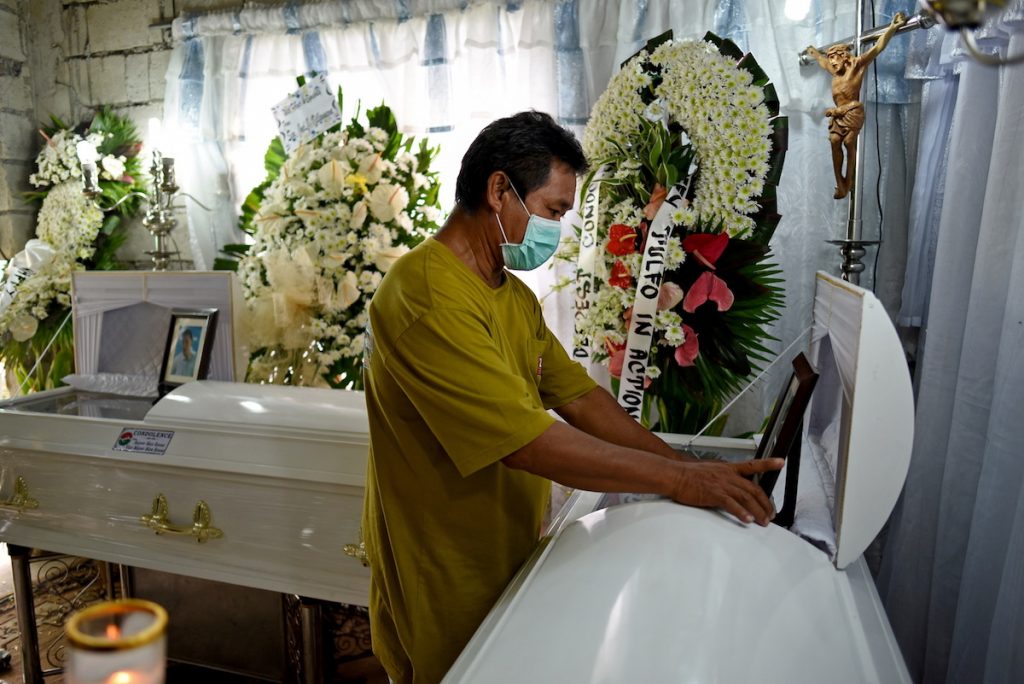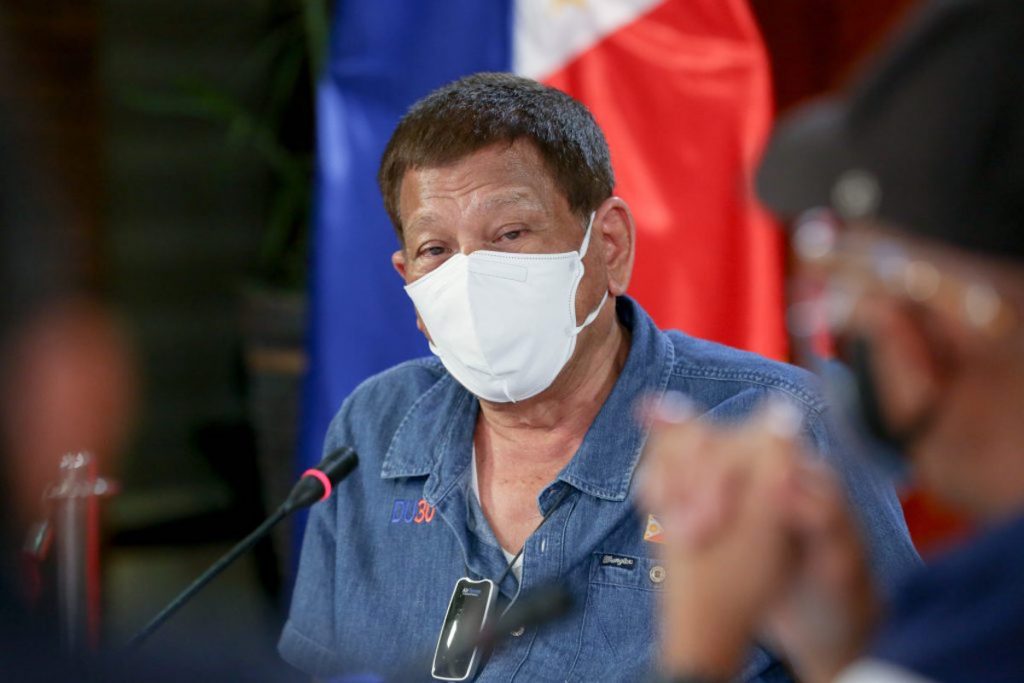It was the child that caught my attention. A petite girl with shoulder-length hair, she stood there calmly, two hands clutching a mobile phone as pleas and angry words swirled around her.
She was clearly documenting an escalating conflict in Paniqui, a town 150 kilometers north of the Philippine capital. Another person from a higher vantage point — another woman in her teens, it turns out — was documenting everything happening on the ground.
A gray-haired woman, Sonia Gregorio, hugged her son, Frank Anthony, a thin, dark-skinned man.
In front of them stood a burly man with a paunch. Senior Master Sgt. Jonel Nuezca’s head swiveled back and forth, responding now and then to the mix of pleas and arguments.
At one point he said, “If you want to carry a gun, be a cop.”
The young girl stepped closer. She screamed, “Just shut up!” The older woman snapped back, “Not us; we’re in our house.”
The girl screamed again, “My father is a police … man!” The other woman screamed, “So what!” followed by a series of wordless playground taunts.
The big man interjected, “You want me to finish you off?”
In less than a second, his arm came up with the gun he had been holding by his side. In broad daylight, with at least half a dozen witnesses, including other children, he shot the mother and son. Two bullets for each; the last ones to guarantee death as they sprawled on the ground.
The girl stepped back, not by much. She did not run like any child would. Witnesses would later say the man approached her, said something, and both walked off. The last video I watched showed another girl, from a window above the bodies, screaming, “Papa, wake up! Wake up, wake up!” Sonya was 54; Anton, 25.

The other side of the mirror
As the viral videos spread across the Philippines — at least three, each taken from a different angle — revulsion and condemnation surged.
What kind of child was this, people asked. What kind of child would smile at the sight of people being held at bay by a man with a gun? What kind of child would gloat about the dynamics of oppression?
I clicked at an assorted number of comments to see the authors’ profiles. Some called for the lynching of the cop and his daughter.
I scoured down those pages. Many were staunch supporters of President Rodrigo Duterte. Many had posts defending a pogrom against suspected drug users and peddlers, echoing his message of death for society’s vermin. Many had also shared posts by military generals calling legal activists terrorists, adding their own demands to have these targets killed as they deserved.
From behind a mirror, they saw a child worthy of lynching — for the very same things they had done in four years of Duterte’s tyrannical rule.
Not all of his supporters were outraged. Many flew to the defense of Nuezca, sniffing that anyone without the sense to fall silent and be abject in the face of a cop with a gun had it coming.
A provincial police chief in Bicol, on the far south of the main island of Luzon, quoted the angry exchange between the cop’s daughter and the woman he killed.
Ariel Buraga had this takeaway: Even when you are old, with white hair, you need to learn to respect our police. He would later take down his post and even the name of his account, although the permanent URL gave away his identity.
‘He’s a lunatic’
Police officials would call the horrific crime “an isolated case”.
It wasn’t.
Pressed by journalists, the national police office released records showing a string of cases in a decade of service, including grave misconduct, serious neglect of duty, refusal to undergo a drug test, and two homicide cases in 2019, both dismissed.
At the time of the Tarlac killings, the cop was working for a crime lab in Paranaque City, a suburb of Manila. Other reports say he had been involved in police anti-drug field operations before that post.
Duterte later ascribed Nuezca’s actions to “lunacy.”
In the Filipino language, during his weekly address from behind his bubble of perpetual isolation, Duterte said, “You probably don’t get it. There’s only one kind of cop who would do this. Someone with mental illness. A lunatic. I’m just wondering how he was able to pass neuro tests. Maybe you can’t detect the person by the way he answers test questions.”
He made no mention of the cop’s record.

If a lunatic person whose knee-jerk response to problems is killing, Duterte should be behind the locked doors of an asylum.
Following “shock and awe” nighttime raids without warrants just north of Manila in February 2018, where cops executed 32 suspects, Duterte hailed his men. “Let’s kill another 32 every day; maybe we can reduce what ails this country,” he egged them on.
“Hitler massacred 3 million Jews … there are 3 million drug addicts (in the Philippines). I’d be happy to slaughter them,” he said in September 2016.
His numbers are false, concocted from thin air, disputed by government anti-narcotics agency heads, who then get fired. More than 8,000 have been killed in police operations.
All fought back, cops claim, despite testimony from eyewitnesses. In one case, police dragged teenager Kian de los Santos through alleys before killing him while he begged for his life. Many families say their slain kin died pleading to be spared.
More than thrice the number of dead in police operations that have fallen in so-called “vigilante” attacks, many of which have been traced to cops.
This month, the International Criminal Court prosecutor’s office said there is “reasonable basis to believe” that Duterte’s government has committed crimes against humanity.
Children learn what they live
Duterte’s kill message extends beyond his drug war.
“If you are corrupt, I will fetch you using a helicopter to Manila and I will throw you out. I have done this before. Why would I not do it again?” he said in December 2016.
Duterte in 2017 threatened to bomb the schools of indigenous children for tribes’ refusal to accept big-ticket development projects on ancestral lands.
He has issued bounties for every communist killed. His military officials have launched a witch hunt against legal activists.
Rights group Karapatan says all 350 activists slain under Duterte’s watch had been demonized as terrorists before their murders.
Human Rights Watch placed Nuezca’s new crimes “in the context of an enabling environment for police violence that President Duterte himself has encouraged.”
“Countless times, Duterte has excused police misconduct and promised to let them off the hook,” said the organization.
A system of impunity gave Nuezca a free pass case after case after case. And four years of Duterte encouraging killings, even ordering them, or threatening these on perceived enemies, have cemented among “protectors of the people” a belief that death is the solution to problems.
Duterte didn’t just encourage. He laid down a policy that trashed due process, that identified several segments of the population as subhumans needing extermination.
That child in the video is a daughter of a cop whose own words betray a monstrous sense of entitlement. A child will absorb what a parent teaches. As they grow older, they either wrap those lessons around them — or they rebel.
Many Filipinos are like that child. They actually call Duterte “father.” They excuse the murders around them, the assaults on citizens as signs of a father’s tough love. They rationalize the bloodshed by saying they feel safer. They dismiss the exposure of corruption scandals, the weaponizing of the law against dissenters, even the prevalence of poverty because their father and his generals blame these as communist propaganda.
There was madness in that video. There is madness all around us.
It is a systemic madness flowing down from the highest reaches of officialdom. It is the kind of lunacy that allows a provincial cop chief to jeer that death is the logical conclusion if you show “disrespect” to a cop with a gun. That, after all, is Duterte’s typical response to dissent.
Most of those who cheer on Duterte are adults with full agency. Or maybe not quite full, given a cultural psyche that has learned through centuries that survival and getting ahead means bowing to and taking on the most graphic displays of power.
This madness in the cultural psyche stems from crazed governance. The madness of fascism seeps down, even to children.
Inday Espina-Varona is an award-winning journalist in the Philippines. She is a recipient of the “Prize for Independence” of the Reporters Without Borders in 2018. The views expressed in this article are the opinions of the author and do not necessarily reflect the editorial stance of LiCAS.news.






